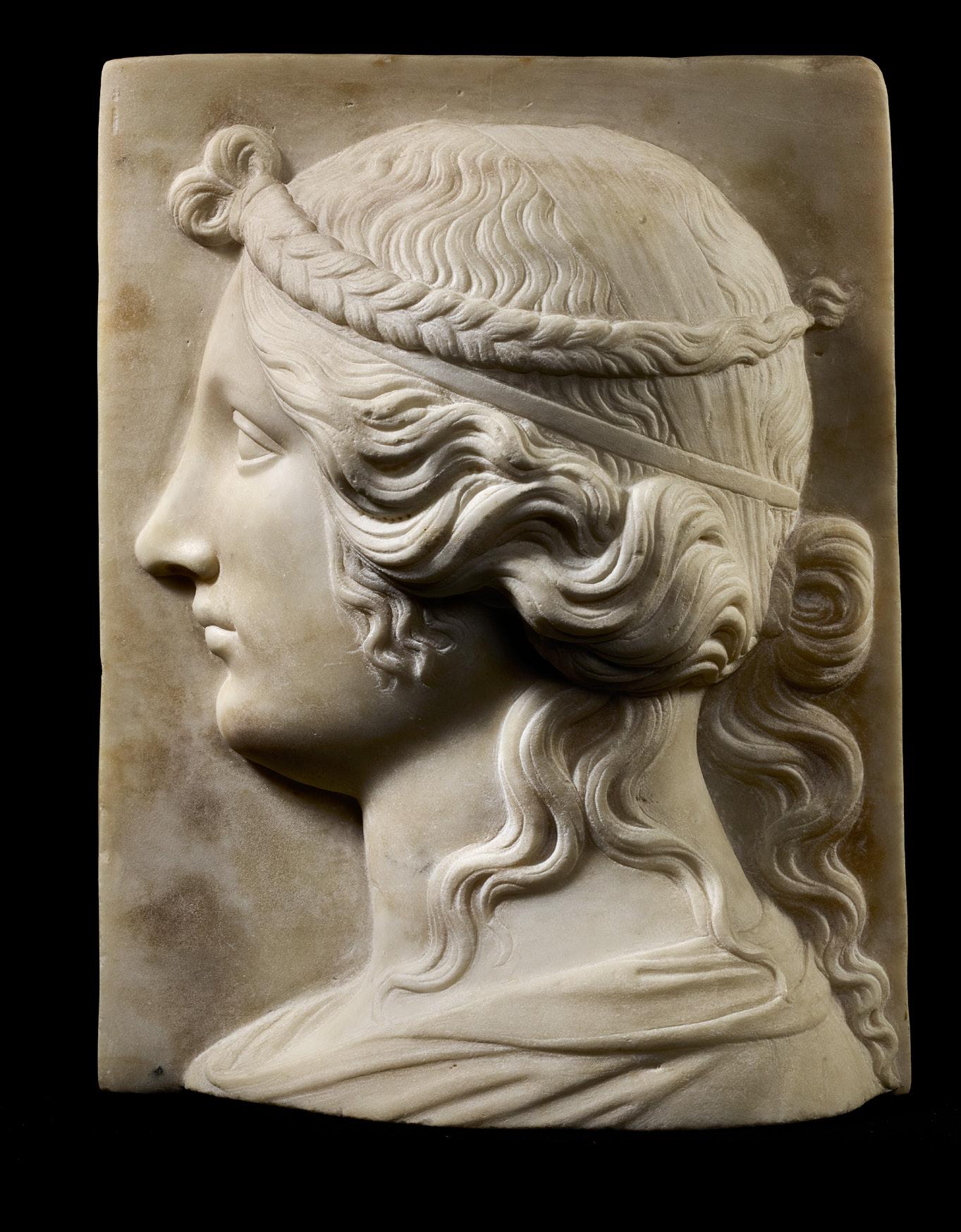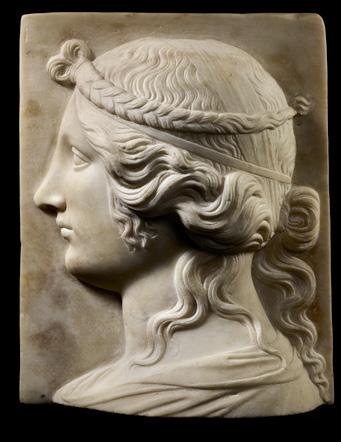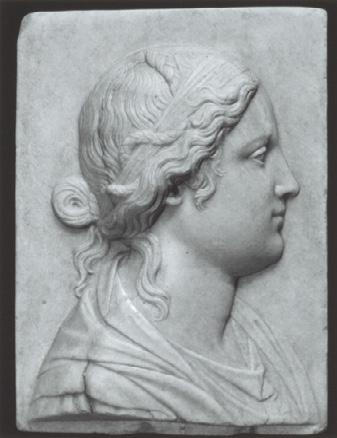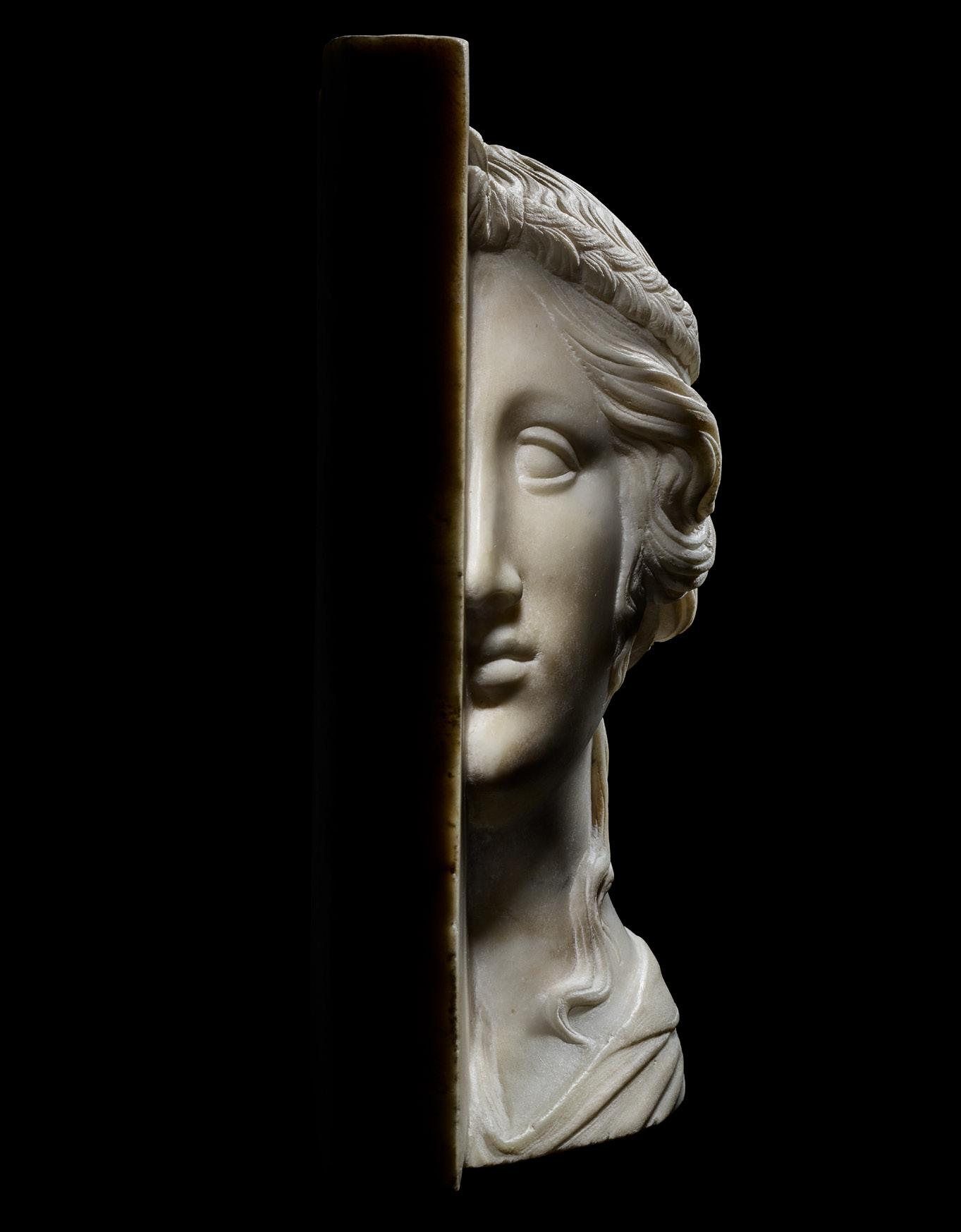
6 minute read
16 Portrait of an Idealized Woman, attributed to Simone di Bianco
16
Advertisement
Simone di Bianco Born in Loro Ciuffenna/Arezzo, Italy, since 1512 active in Venice – after 1553, attributed to
Circa 1520/30 White marble relief Height: 30 cm, length: 23.5 cm, width: 8.5 cm
Provenance: With Charles Beddington, London, 2014; private collection, England
Related Literature: Bacchi, Andrea and Giacomell, Lucianai (eds.). Rinascimento e Passione – Andrea Riccio e il suo tempo, exh. cat., Trient 2000, no. 116 (fig.)
Kryza-Gersch, Claudia. ‘Discovered in the stores. Two female busts by Simone Bianco in the Kunsthistorisches Museum in Vienna’ in: Peta Motture, Emma Jones and Dimitrios Zikos (eds.), Carvings, Casts and Collectors, London 2013, pp. 72 – 87 id., ‘Simone Bianco. Venezianische Skulptur zwischen Antikenbegeisterung und Antikenfälschung’ in: Sascha Kansteiner (ed.), Transformationen der Antike, vol. 45: Pseudoantike Skulptur I. Fallstudien zu antiken Skulpturen und ihren Imitationen, Berlin 2016, pp. 9 – 24
Luchs, Alison. Tullio Lombardo and ideal portrait sculpture in Renaissance Venice, 1490–1530, Cambridge 1995
Markham Schulz, Anne. ‘Simone Bianco, The Grimani collection of antiquities and other unexpected findings’ in: Jahrbuch des Kunsthistorischen Museums Wien, vol. 17/18 (2015/2016), pp. 26 – 43
Id. The History of Venetian Renaissance Sculpture. ca. 1400 – 1530, London, Turnhout 2017, pp. 355 – 365
Meller, Peter. ‘Marmi e bronzi die Simone Bianco’ in: Mitteilungen des Kunsthistorischen Institutes in Florenz, vol. XXI, 1977, pp. 199 – 210
Schlegel, Ursula. ‘Simone Bianco und die venezianische Malerei’ in: Mitteilungen des Kunsthistorischen Institutes in Florenz, 23.1979, pp. 187 – 196
16


Simone Bianco, Profile Portrait of a Woman, white marble, Galleria Estense, Modena, inv. no. 2045
This marble relief depicts an elegant woman’s head in strict profile. The classical profile view, a motif from Antiquity, was initially adopted in the Renaissance for coins and medals before appearing in the form of stone reliefs as a conscious citation of Ancient Greece and Rome. The well-proportioned face – the closed lips, straight nose and calm expression – is framed by an unusual, elaborate hairstyle: her carefully plaited tresses, tied into a bow on her forehead, have been draped into a coil on her smoothly combed hair. From the temple, thick strands of hair fall onto the neck; several are turned slightly inwards giving the image a particularly sensuous appeal. The hair is additionally held in place by a narrow ribbon. The artistically arranged coiffeur gives this image of a woman a contemporary appearance. The robe over her shoulders, on the other hand, emulates models from Antiquity.
Stylistically, the unsigned relief is to be assigned to Venetian art of around 1520/30. The profile portrait in relief form was popular in the whole of Italy in the last quarter of the 15th century. In Venice, however, a unique style, influenced by Antiquity, evolved at the beginning of the 16th century, initiated through the work of Pietro and Tullio Lombardo. The classical facial features reminiscent of Antiquity and the precise execution of the hair, in particular, point to the sculptor Simone Bianco. Simone Bianco came from the province of Arezzo. The exact place and date of birth are unknown. Bianco is first mentioned in documents in 1512 in Venice. As a successor to Tullio und Antonio Lombardo he had a decisive influence on the development of Venetian portrait sculpture in a secular context up until 1530. Unlike Florence, portrait sculpture in Venice in the 15th century was concentrated on public spaces. It was not until the first third of the 16th century that wealthy residents of la Serenissima gradually commissioned sculptors to make copies of ancient works or portraits in the style of works from Antiquity, with an increasingly individual character, for private households.1
Simone Bianco, whose œuvre has been the subject of intensive research over the past few years, seemed to have been the driving force behind this development. The famous poet and a contemporary of his, Pietro Aretino, praised Bianco’s works, drawing comparisons with Titian. Among other statements he also reported that three busts had been sent to the French king and that Bianco was “ a decent person, a good sculptor and great friend.”2 It would appear that this artist and his delicately executed sculptures quite wrongly sank into oblivion. As he seldom signed his works, his sculptures were often not attributed to him. Bianco’s artistic legacy – often mentioned in sources – was consequently little known and his works frequently lay undiscovered as ‘works of Antiquity’ in museum depots.3
1 For further details, see: LUCHS 1995. 2 KRYZA-GERSCH 2013, here: 74 – 75. 3 Ibid., on the two busts of women recently discovered in Vienna
Finds made over the past few years, however, have revealed that Simone Bianco had his own distinctive handwriting. His masterly skill can be seen, in particular, in the detailed execution of the hair which always forms a complex composition of plaits and intertwined strands. Although the sculptural treatment of the hair is similar, no one hairstyle is repeated, it is always being modified instead.
Two works prove that Simone Bianco also worked on reliefs.4 A figure of Christ in Pommersfelden and a relief portrait of a woman. This profile portrait of a woman in the Galleria Estense in Modena, in particular, is very similar to our relief. The succinct physiognomy of Classical Antiquity and the exquisitely executed hair, right down to the last detail. Despite this being a flat relief, the perspectively depicted foreshortening of the folds in the garment and the pronounced, three-dimensional plaits and curls are also typical of Simone Bianco. The relief in Modena has also recently and convincingly been included in the sculptor’s œuvre. If one compares the two reliefs, there can be no doubt that they must have been executed by one and the same sculptor. The lower border of the relief stone, similarly worked in both cases, also speaks in favour of this. To date, however, it has not been possible to compile a chronology for the few works.5
It is certain that Bianco started his activities before 1512 and was still alive in 1553. He received many commissions and was highly skilled in making works to meet the wishes of collectors. That this relief was created around 1530, when the artist had reached the peak of his career, is highly plausible. The relief discussed here is also very much in keeping with Simone Bianco’s style that oscillates between all antico, on the one hand, and contemporary, on the other. Interestingly, Bianco’s idealised portraits of women, unlike his busts of men, for example, do not depict heroines from Classical Antiquity. Neither are they contemporary portraits. The style of Bianco’s work could be described as hybrid – moving little by little towards individualised portraiture from the certainty of the pictorial tradition of Antiquity.
Or else his busts are creations in the style of ‘beautiful Venetian women’ to whom Palma Vecchio, Titian and Paris Bordone paid homage in their paintings, executed at the same time. Giorgione established a paradigm for this new genre of female portraiture in Venetian painting with his Laura in 1506. The identity of his model remains uncertain; the ideal of female beauty being celebrated, pars pro toto, in his depiction. Our unknown beauty with her classical profile also fits perfectly into this artistic category.
16
3 Kryza-Gersch 2016, on the signed relief of Christ in Pommersfelden; the relief in
Modena is attributed to Bianco by Anne Markham Schulz, see: Markham Schulz, here: p. 39 fig. 13, and pp. 40 – 41.
4 This was attempted by Kryza-Gersch in 2013 who, however, notes: „Although the chronology proposed so far does not seem unreasonable, a word of caution should be added. As already pointed out by Anne Markham Schulz, Simone must have been able to switch his style according to the nature of his commission.“, p. 82.

Simone Bianco, Profile Portrait of a Woman, white marble, Galleria Estense, Modena, inv. no. 2045







